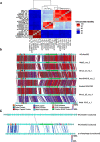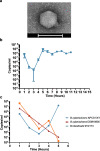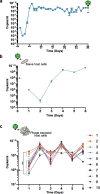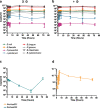Isolation and characterisation of ΦcrAss002, a crAss-like phage from the human gut that infects Bacteroides xylanisolvens
- PMID: 33845877
- PMCID: PMC8042965
- DOI: 10.1186/s40168-021-01036-7
Isolation and characterisation of ΦcrAss002, a crAss-like phage from the human gut that infects Bacteroides xylanisolvens
Abstract
Background: The gut phageome comprises a complex phage community of thousands of individual strains, with a few highly abundant bacteriophages. CrAss-like phages, which infect bacteria of the order Bacteroidales, are the most abundant bacteriophage family in the human gut and make an important contribution to an individual's core virome. Based on metagenomic data, crAss-like phages form a family, with four sub-families and ten candidate genera. To date, only three representatives isolated in pure culture have been reported: ΦcrAss001 and two closely related phages DAC15 and DAC17; all are members of the less abundant candidate genus VI. The persistence at high levels of both crAss-like phage and their Bacteroidales hosts in the human gut has not been explained mechanistically, and this phage-host relationship can only be properly studied with isolated phage-host pairs from as many genera as possible.
Results: Faeces from a healthy donor with high levels of crAss-like phage was used to initiate a faecal fermentation in a chemostat, with selected antibiotics chosen to inhibit rapidly growing bacteria and selectively enrich for Gram-negative Bacteroidales. This had the objective of promoting the simultaneous expansion of crAss-like phages on their native hosts. The levels of seven different crAss-like phages expanded during the fermentation, indicating that their hosts were also present in the fermenter. The enriched supernatant was then tested against individual Bacteroidales strains isolated from the same faecal sample. This resulted in the isolation of a previously uncharacterised crAss-like phage of candidate genus IV of the proposed Alphacrassvirinae sub-family, ΦcrAss002, that infects the gut commensal Bacteroides xylanisolvens. ΦcrAss002 does not form plaques or spots on lawns of sensitive cells, nor does it lyse liquid cultures, even at high titres. In keeping with the co-abundance of phage and host in the human gut, ΦcrAss002 and Bacteroides xylanisolvens can also co-exist at high levels when co-cultured in laboratory media.
Conclusions: We report the isolation and characterisation of ΦcrAss002, the first representative of the proposed Alphacrassvirinae sub-family of crAss-like phages. ΦcrAss002 cannot form plaques or spots on bacterial lawns but can co-exist with its host, Bacteroides xylanisolvens, at very high levels in liquid culture without impacting on bacterial numbers. Video abstract.
Keywords: Bacteriophages; Human gut phageome; Human microbiome; Phage-host interactions; crAss-like phages; crAssphage.
Conflict of interest statement
The authors declare that they have no competing interests.
Figures







Similar articles
-
Adaptations in gut Bacteroidales facilitate stable co-existence with their lytic bacteriophages.Gut Microbes. 2025 Dec;17(1):2507775. doi: 10.1080/19490976.2025.2507775. Epub 2025 May 23. Gut Microbes. 2025. PMID: 40407098 Free PMC article.
-
Adaptations in gut Bacteroidales facilitate stable co-existence with their lytic bacteriophages.bioRxiv [Preprint]. 2024 Nov 17:2024.11.17.624012. doi: 10.1101/2024.11.17.624012. bioRxiv. 2024. Update in: Gut Microbes. 2025 Dec;17(1):2507775. doi: 10.1080/19490976.2025.2507775. PMID: 39605433 Free PMC article. Updated. Preprint.
-
Biology and Taxonomy of crAss-like Bacteriophages, the Most Abundant Virus in the Human Gut.Cell Host Microbe. 2018 Nov 14;24(5):653-664.e6. doi: 10.1016/j.chom.2018.10.002. Epub 2018 Oct 25. Cell Host Microbe. 2018. PMID: 30449316
-
The crAss-like Phage Group: How Metagenomics Reshaped the Human Virome.Trends Microbiol. 2020 May;28(5):349-359. doi: 10.1016/j.tim.2020.01.010. Epub 2020 Feb 28. Trends Microbiol. 2020. PMID: 32298613 Review.
-
CrAss-Like Phages: From Discovery in Human Fecal Metagenome to Application as a Microbial Source Tracking Marker.Food Environ Virol. 2024 Jun;16(2):121-135. doi: 10.1007/s12560-024-09584-5. Epub 2024 Feb 27. Food Environ Virol. 2024. PMID: 38413544 Review.
Cited by
-
Prokaryotic and viral genomes recovered from 787 Japanese gut metagenomes revealed microbial features linked to diets, populations, and diseases.Cell Genom. 2022 Nov 30;2(12):100219. doi: 10.1016/j.xgen.2022.100219. eCollection 2022 Dec 14. Cell Genom. 2022. PMID: 36778050 Free PMC article.
-
Impact of a phage cocktail targeting Escherichia coli and Enterococcus faecalis as members of a gut bacterial consortium in vitro and in vivo.Front Microbiol. 2022 Jul 22;13:936083. doi: 10.3389/fmicb.2022.936083. eCollection 2022. Front Microbiol. 2022. PMID: 35935217 Free PMC article.
-
Identification and characterization of Faecalibacterium prophages rich in diversity-generating retroelements.Microbiol Spectr. 2025 Feb 4;13(2):e0106624. doi: 10.1128/spectrum.01066-24. Epub 2024 Dec 31. Microbiol Spectr. 2025. PMID: 39745426 Free PMC article.
-
CrAssphage May Be Viable Markers of Contamination in Pristine and Contaminated River Water.mSystems. 2023 Feb 23;8(1):e0128222. doi: 10.1128/msystems.01282-22. Epub 2023 Feb 6. mSystems. 2023. PMID: 36744944 Free PMC article.
-
Phage-encoded carbohydrate-interacting proteins in the human gut.Front Microbiol. 2023 Jan 6;13:1083208. doi: 10.3389/fmicb.2022.1083208. eCollection 2022. Front Microbiol. 2023. PMID: 36687636 Free PMC article. Review.
References
Publication types
MeSH terms
Supplementary concepts
LinkOut - more resources
Full Text Sources
Other Literature Sources

